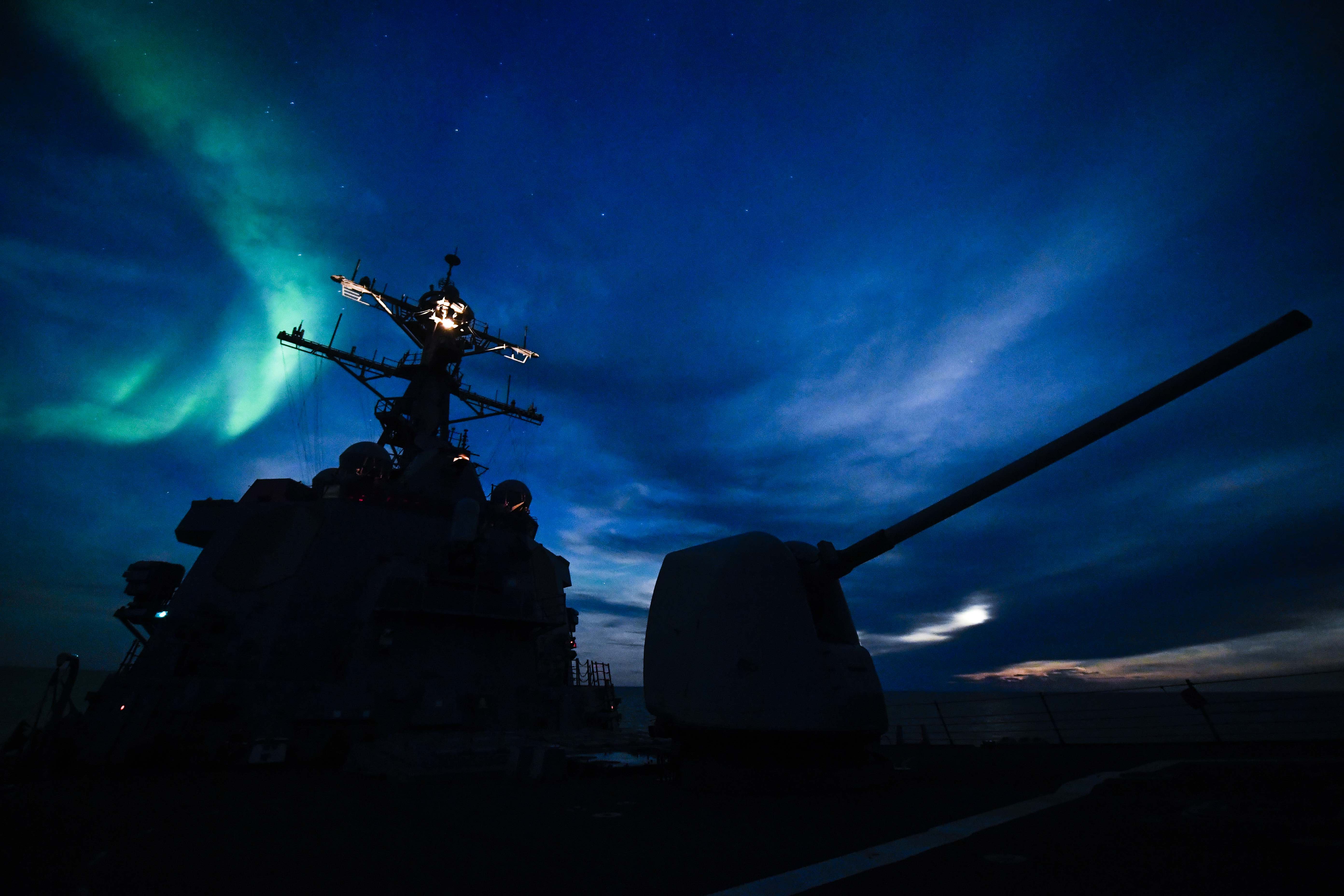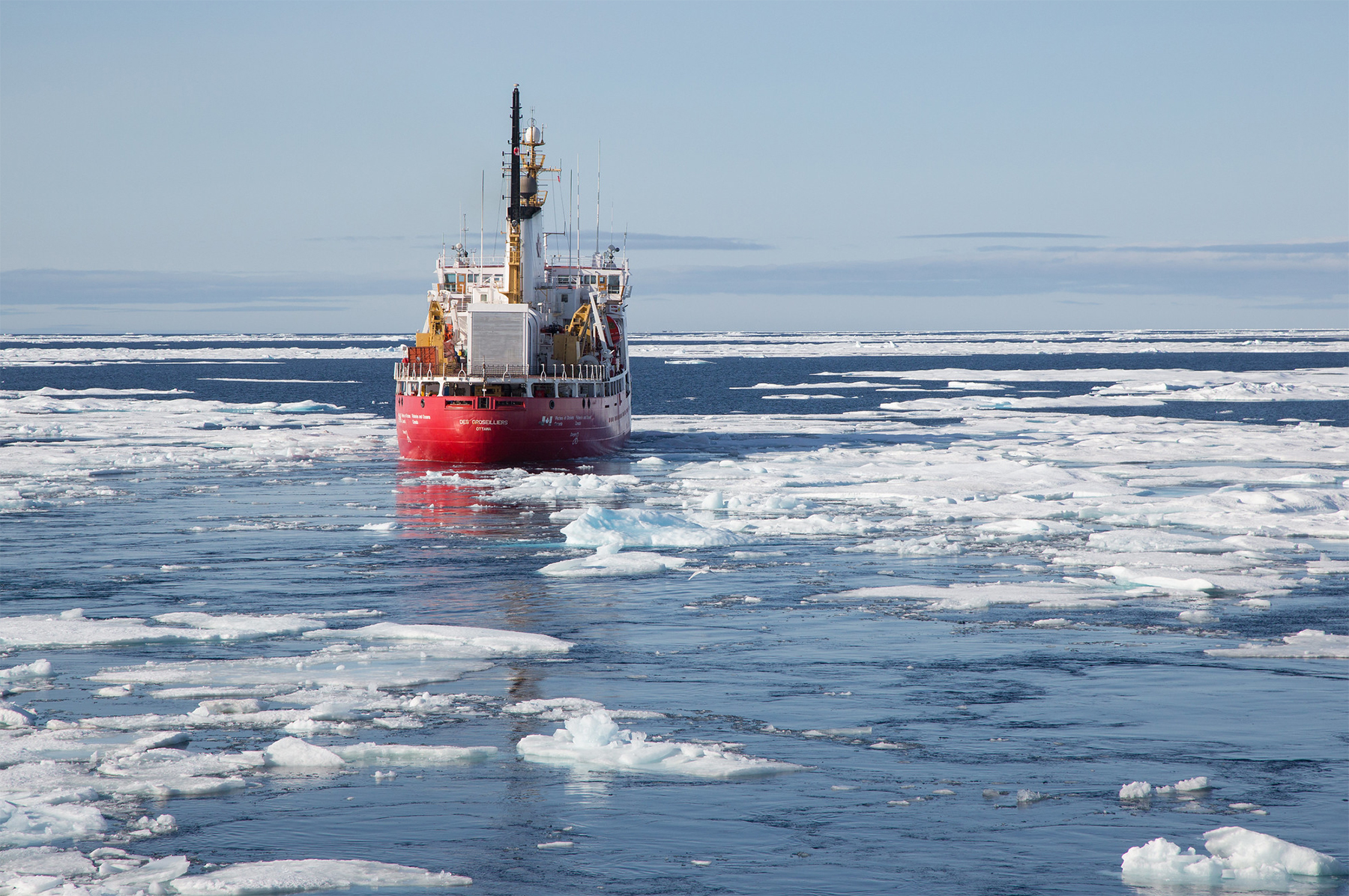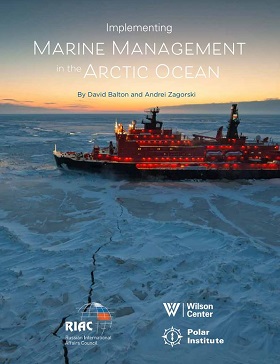The activity of the United States Navy and the U.S.’s NATO allies in the Arctic is becoming a standing factor. The visit to the Barents Sea by a group of destroyers, regular under-ice exercises by nuclear submarines, the air patrol over Iceland, the formation of a new fleet with an Arctic zone of responsibility and Donald Trump’s initiative to build new heavy icebreakers for the U.S. Navy: these are all reasons for re-evaluating the prospects for NATO-Russia relations in the region and a possible change in the balance of power.
The end of the first Cold War and the subsequent collapse of the Soviet Union led to a sharp decline in military activity in the Arctic on both sides: Russia and the United States ceased to regard the region as a likely battlefield in the near future.
Many military installations were abandoned during this period. In the Russian North, the civilian population, which had grown during the Soviet period as Arctic resources were actively developed and military presence in the region was enhanced, also declined significantly. By the second half of the 1990s, this presence was reduced to occasional exercises by the Air Force and limited activity of the Northern Fleet, primarily in the Barents and Kara Seas.
One of the ways for Russia to build capacity in the region that comes with a touch of good “peaceful” P.R. is to strengthen the “civil police” infrastructure. First of all, we are talking about building up coast guard forces, including aviation; ice, hydrological and weather reconnaissance capabilities; the Earth remote sensing satellite fleet; construction and repair of ports; and a number of other areas that could be developed through the activities of commercial companies, civilian entities and law enforcement agencies. If necessary, this infrastructure could be used to achieve the country’s defence objectives, be it border patrol ships, airplanes and helicopters of the air medical service, police or border guard, as well as satellites and other means.
Such growth of “non-military” activity in the Arctic would help, among other things, to promote the Northern Sea Route as a choice for commercial shipping (by improving the supporting services) and would facilitate negotiations with potential partners that need the NSR for their own purposes (first of all, China).
Several publications in the West have already referred to the interaction between Russia and NATO in the Arctic as the “Big Game,” which brings up obvious associations with the historical rivalry between Russia and Great Britain in South and Central Asia in the 19th to early 20th centuries. This term probably fits the current conditions but must be interpreted correctly. The Big Game between London and St. Petersburg for dominance in Asia was not a primitive military rivalry but rather a competition of long-term plans and the will of the state. Controlled territories were systematically developed in order to lay solid foundations for protection against attacks by hostile forces and, if necessary, advancing further South (for Russia) and North (for Britain). In relation to the Arctic, this model also implies a primary focus on the comprehensive development of the region, making military deployment a natural continuation of civilian activity. In this scenario, the military forces may use the extensive civilian and commercial infrastructure rather than hang in a strategic vacuum, where the loss of any one element cannot be compensated for. It should be noted that, given its geographical features and the existing economic infrastructure, such a development presents no difficulties for Russia and is much more useful both economically and politically than it would be to awaken the ancient ghosts of exchanging nuclear strikes with the U.S. along the transpolar route.
The activity of the United States Navy and the U.S.’s NATO allies in the Arctic is becoming a standing factor. The visit to the Barents Sea by a group of destroyers, regular under-ice exercises by nuclear submarines, the air patrol over Iceland, the formation of a new fleet with an Arctic zone of responsibility and Donald Trump’s initiative to build new heavy icebreakers for the U.S. Navy: these are all reasons for re-evaluating the prospects for NATO-Russia relations in the region and a possible change in the balance of power.
Small North
The end of the first Cold War and the subsequent collapse of the Soviet Union led to a sharp decline in military activity in the Arctic on both sides: Russia and the United States ceased to regard the region as a likely battlefield in the near future.
Many military installations were abandoned during this period. In the Russian North, the civilian population, which had grown during the Soviet period as Arctic resources were actively developed and military presence in the region was enhanced, also declined significantly. By the second half of the 1990s, this presence was reduced to occasional exercises by the Air Force and limited activity of the Northern Fleet, primarily in the Barents and Kara Seas.
The first hints of a possible intensified renewal of military activity in the region appeared in the 2000s, when the U.S. Navy started the regular Ice Exercises (ICEX) to train submarines for combat use in the ice, including target search and tracking, torpedo firing and deployment of ice stations. In the same period, Russian aviation intensified its presence in the North: strategic bomber flights became, if not frequent, then at least regular.
This intermittent activity throughout the 2000s did not change the situation in the region as a whole: the Arctic remained calm and scantily populated, as economic activity beyond the Arctic Circle was also minimal.
Russia began seriously restoring its long-term military presence in the Arctic in the 2010s. In 2014, it established a separate Joint Strategic Command North, the main force of which was the Russian Navy’s Northern Fleet. In the same period, active construction of new military bases and renovation of some old ones was launched. Work got underway in almost the entire Russian sector of the Arctic: on the islands of Franz Josef Land, the Novaya Zemlya and Severnaya Zemlya archipelagos, Novosibirsk Islands, Wrangel Island, as well as on the mainland, from the Kola Peninsula to Chukotka.
The renewed military presence was needed primarily to ensure control over Russian waters and airspace, given their growing economic importance. In 2013, oil production started at the Prirazlomnoye field, and the construction of the Port of Sabetta began as part of the Yamal LNG project. In the same year, the lead nuclear icebreaker Arktika of the new LK-60Ya type was laid down in St. Petersburg.
Balance of Power
Now, in 2020, the balance of power between the key players in the Arctic looks relatively favourable for the Russian Federation. Russia’s geographical position allows it to control a significant share of the Arctic Ocean, which is also most accessible navigation-wise. The only Artic power that can boast better conditions is Norway, with its entire coast washed by ice-free seas. Compared to Canada and the United States, the Russian Arctic is characterised by a greater length of navigation, a smaller area and thickness of the ice cover, as well as a big number of bases and ports along the coast and on islands. The Northern Sea Route (NSR) is in regular and increasing use for commercial cargo transport, owing to both development of the resources of the Russian North and transit shipping. Of course, the NSR is still a long way behind the routes of the southern seas in performance, but the prospects for its development are great.
At the same time, the growing rift between Russia and NATO, largely (but only partly) caused by the events in Ukraine in 2014, prompted the Western powers to step up their activity in the region, too. In 2015, NATO held the Arctic Challenge — its first major air force exercises in the Arctic — with the participation of neutral partner states: Finland, Sweden and Switzerland. In the autumn of 2018, Norway and its surrounding waters hosted the Trident Juncture 2018, the biggest exercises since the collapse of the USSR. The purpose of the manoeuvres was to test the fighting capacity of the NATO Rapid Response Force and the participating countries’ ability to manage allied support in an effective way.
Even before the Ukrainian events, the Alliance began to restore its military presence in Iceland, which had almost ceased after American aircraft withdrew from Naval Air Station Keflavik in 2006. The NATO air patrol, originally announced as an exclusively unarmed mission with observational goals, was launched in 2007, the level of readiness was raised in 2013 and, since 2014, the patrol regularly carries out interception operations with weapons on board.
In the early spring of 2020, NATO planned to conduct the Cold Response 2020 exercises in the Arctic to train military personnel for action at low and extremely low temperatures. Still, the coronavirus interfered with these plans and the manoeuvres, which had scarcely begun, had to be aborted.
When a group of NATO ships, consisting of a British frigate and three destroyers of the U.S. Navy’s 6th Fleet, entered into the Barents Sea in May 2020, it was a logical continuation of the general trend of expanding NATO activity in the region.
As regards further opportunities for building up forces, Russia and the Alliance are in different positions. Despite having a relatively modest Arctic infrastructure, with most of its facilities being concentrated in Norway and a small number of others spread thinly from Iceland to Alaska, NATO has significant financial resources. In the medium and long term, the Alliance, primarily the United States, will be able to increase its presence in the region substantially.
If the American leadership decides to upgrade the icebreaker fleet radically (including by building nuclear icebreakers), this will greatly simplify the establishment and maintenance of bases on the islands of the Canadian Arctic Archipelago but, even now, using mainly air delivery, the Alliance is capable of deploying significant air forces in the Arctic, many times more than are currently available. This would increase the permanent presence in the Arctic from dozens to hundreds of combat and utility aircraft. In terms of naval forces, preparations for a possible build-up are already underway and the possible basis for this could be, first of all, the U.S. Navy’s 2nd fleet, reconstructed in 2018, operating in the North Atlantic, including the Arctic.
Moreover, Russia’s capacity for building up forces in the Arctic beyond those currently deployed is currently quite limited. The main hindrances are the inadequate capabilities of military transport aircraft, including the deficit of special vehicles, such as tanker aircraft and AEW systems; the Russian Navy’s acute shortage of warships of its main classes; and slow rate at which they are being built. In fact, the Russian Navy has never got over the post-Soviet crisis that both led to the lack of combat units and clouded the outlook for fleet development. As a result, Navy upgrade programmes are insufficient in scope and adjusted too frequently in response to momentary factors.
At the same time, deployment of new Russian military facilities in the Arctic is often overdramatised in the media, which tends to focus on their possible use for deploying nuclear weapons. This may not be the best approach in the current situation, given the importance of the media background when military-political decisions are taken. In fact, news regarding the possible deployment of some Russian strategic nuclear forces in the Arctic, beyond the historically deployed Northern Fleet ballistic missile submarines, could create a certain political background that the NATO leadership would use to justify and expand their own military activity in the region.
One of the ways for Russia to build capacity in the region that comes with a touch of good “peaceful” P.R. is to strengthen the “civil police” infrastructure. First of all, we are talking about building up coast guard forces, including aviation; ice, hydrological and weather reconnaissance capabilities; the Earth remote sensing satellite fleet; construction and repair of ports; and a number of other areas that could be developed through the activities of commercial companies, civilian entities and law enforcement agencies. If necessary, this infrastructure could be used to achieve the country’s defence objectives, be it border patrol ships, airplanes and helicopters of the air medical service, police or border guard, as well as satellites and other means.
Such growth of “non-military” activity in the Arctic would help, among other things, to promote the Northern Sea Route as a choice for commercial shipping (by improving the supporting services) and would facilitate negotiations with potential partners that need the NSR for their own purposes (first of all, China).
Return of the “Big Game” Several publications in the West have already referred to the interaction between Russia and NATO in the Arctic as the “Big Game,” which brings up obvious associations with the historical rivalry between Russia and Great Britain in South and Central Asia in the 19th to early 20th centuries. This term probably fits the current conditions but must be interpreted correctly. The Big Game between London and St. Petersburg for dominance in Asia was not a primitive military rivalry but rather a competition of long-term plans and the will of the state. Controlled territories were systematically developed in order to lay solid foundations for protection against attacks by hostile forces and, if necessary, advancing further South (for Russia) and North (for Britain). In relation to the Arctic, this model also implies a primary focus on the comprehensive development of the region, making military deployment a natural continuation of civilian activity. In this scenario, the military forces may use the extensive civilian and commercial infrastructure rather than hang in a strategic vacuum, where the loss of any one element cannot be compensated for. It should be noted that, given its geographical features and the existing economic infrastructure, such a development presents no difficulties for Russia and is much more useful both economically and politically than it would be to awaken the ancient ghosts of exchanging nuclear strikes with the U.S. along the transpolar route.







